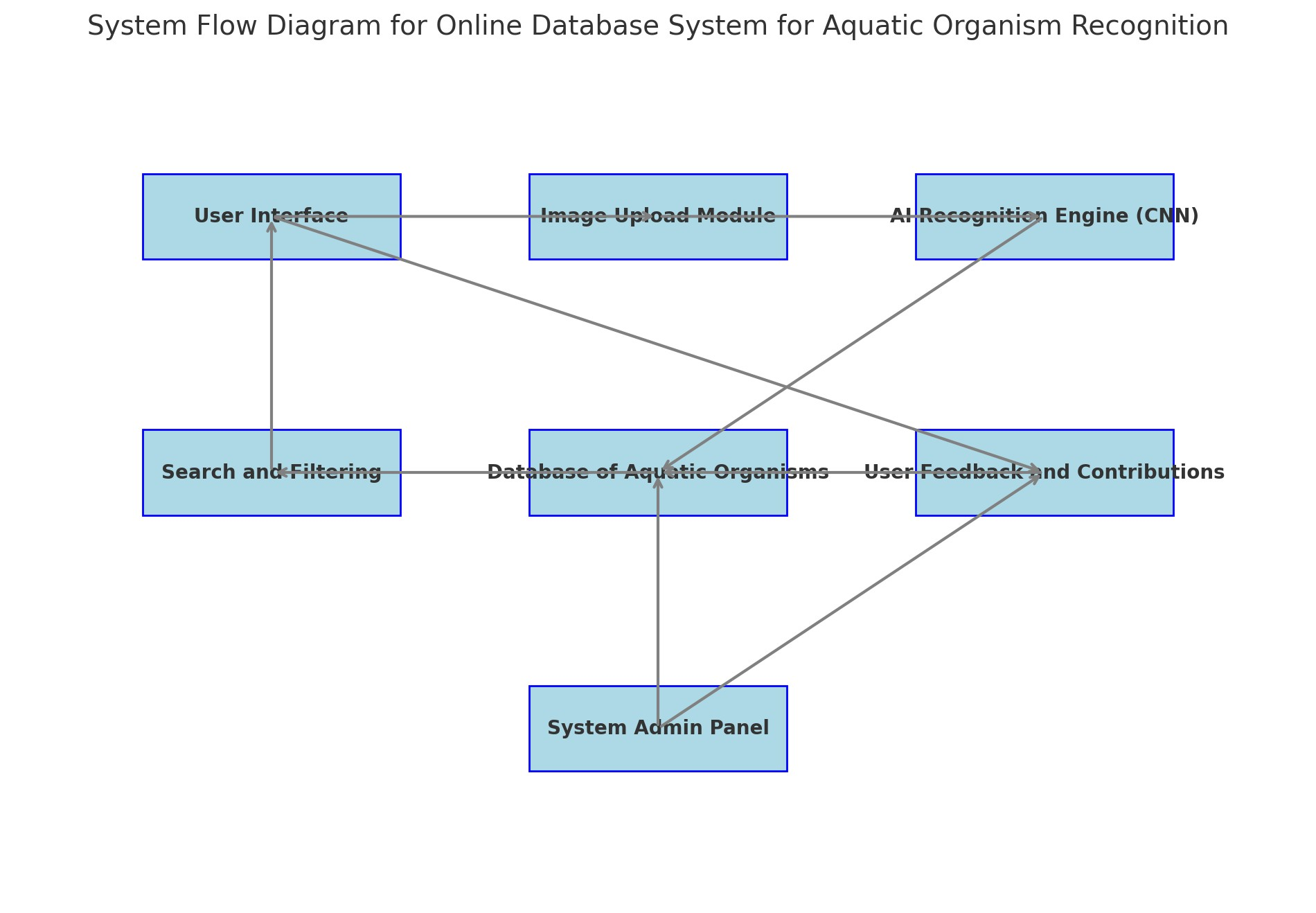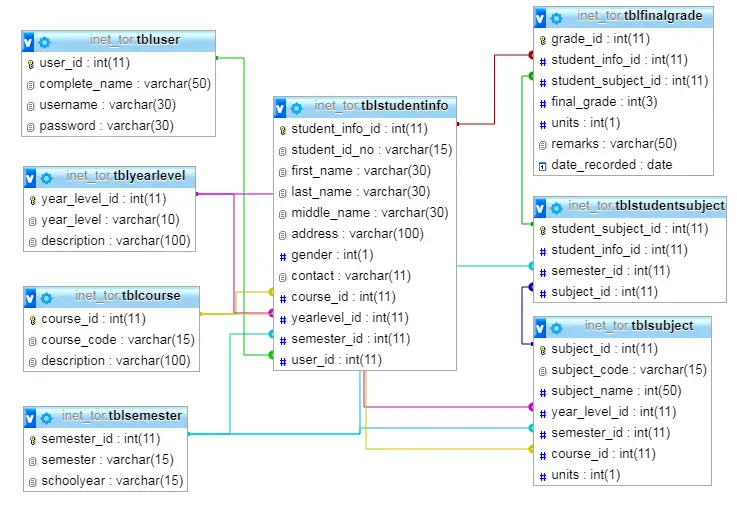Online Database System for Aquatic Organism Recognition
Background of the Study
Table of Contents
The identification of aquatic organisms plays a crucial role in understanding and preserving the health of our planet’s water ecosystems. From monitoring biodiversity to assessing the impact of climate change, accurate species recognition is essential for researchers, conservationists, and policymakers. Aquatic organisms, including fish, corals, and plankton, are vital indicators of ecosystem health, and their identification helps in tracking environmental changes, preventing invasive species, and supporting sustainable fisheries.
However, traditional methods of identifying aquatic species often face significant challenges. Manual identification relies heavily on expert knowledge, which can be time-consuming and prone to human error. Additionally, the vast diversity of aquatic life, coupled with the subtle differences between species, makes it difficult for non-experts to accurately classify organisms. These limitations highlight the need for more efficient and accessible solutions.
This is where online databases and artificial intelligence (AI) come into play. Online databases provide a centralized platform for storing and sharing information about aquatic species, making it easier for researchers and enthusiasts to access valuable data. When combined with AI, particularly machine learning and image recognition technologies, these databases can automate the identification process. AI-powered systems can analyze images, detect patterns, and classify species with remarkable accuracy, significantly reducing the time and effort required for manual identification.
By leveraging the power of online databases and AI, we can revolutionize the way aquatic organisms are identified and studied. This not only enhances the efficiency of biodiversity monitoring but also empowers a wider audience, including students, citizen scientists, and conservationists, to contribute to the protection of our aquatic ecosystems. As technology continues to advance, the integration of these tools promises to unlock new possibilities for understanding and preserving the rich diversity of life beneath the water’s surface.
Problem Statement
The manual identification and cataloging of aquatic organisms present significant challenges for researchers and marine biologists. With thousands of species inhabiting diverse aquatic ecosystems, accurately distinguishing between them requires specialized expertise and extensive time. This process is further complicated by the subtle morphological differences among species, as well as the dynamic nature of aquatic environments, where species may evolve or migrate over time. As a result, manual identification is not only labor-intensive but also prone to errors, limiting the efficiency and scalability of biodiversity studies.
Compounding this issue is the lack of centralized and accessible online databases tailored to the needs of researchers and marine biologists. While some databases exist, they are often fragmented, outdated, or limited in scope, making it difficult to access comprehensive and up-to-date information. This fragmentation hinders collaboration among scientists and restricts the ability to share critical data on aquatic species. Furthermore, the absence of user-friendly platforms that integrate advanced technologies, such as artificial intelligence, limits the potential for automating species identification and analysis.
These challenges underscore the urgent need for a unified, accessible, and technologically advanced solution. By addressing the difficulties in manual identification and the gaps in existing databases, we can empower researchers and marine biologists to more effectively study, monitor, and conserve aquatic ecosystems. This will not only enhance our understanding of aquatic biodiversity but also support global efforts to protect these vital resources for future generations.
Objectives of the Study
The primary goal of this study is to address the challenges in aquatic organism identification by creating an innovative and accessible solution. The specific objectives are as follows:
- Develop an Online Database System for Aquatic Organism Recognition
To create a centralized, comprehensive, and easily accessible online database that houses detailed information about various aquatic species. This database will serve as a reliable resource for researchers, marine biologists, and enthusiasts, enabling them to efficiently store, retrieve, and share data on aquatic organisms. - Implement AI-Based Image Recognition for Species Identification
To integrate advanced artificial intelligence (AI) and machine learning algorithms, particularly image recognition technology, into the system. This feature will allow users to upload images of aquatic organisms, which the system will automatically analyze and classify into specific species. By leveraging AI, the system aims to improve the accuracy, speed, and scalability of species identification compared to traditional manual methods. - Provide a User-Friendly Interface for Researchers and Enthusiasts
To design an intuitive and user-friendly interface that caters to both experts and non-experts. The platform will be easy to navigate, with features such as image upload, species search, and data visualization, making it accessible to a wide range of users, including researchers, students, and citizen scientists. The goal is to democratize access to aquatic biodiversity data and foster greater collaboration and engagement in conservation efforts.
Significance of the Study
- Benefits to Marine Biologists, Researchers, and Environmental Agencies
The development of an Online Database System for Aquatic Organism Recognition will greatly benefit professionals involved in marine research and conservation. This system will:
- Enhance Research Efficiency – Researchers can quickly identify species using AI-powered image recognition, reducing the time needed for manual classification.
- Provide a Centralized Information Hub – A unified database will allow marine biologists to access accurate and updated species data in one platform.
- Support Collaborative Studies – The system can facilitate knowledge sharing among scientists, universities, and environmental agencies, fostering global cooperation.
- Improve Conservation Efforts – Faster and more accurate species identification will help detect endangered or invasive species, aiding in ecosystem protection.
- Contributions to Biodiversity Monitoring and Conservation
Biodiversity plays a crucial role in maintaining ecological balance, and effective species identification is key to monitoring changes in aquatic ecosystems. This system will:
- Aid in Tracking Species Population Trends – Researchers can analyze collected data to observe shifts in aquatic biodiversity over time.
- Help Identify Invasive Species – Early detection of invasive species can prevent ecological disruptions and economic losses in fisheries.
- Support Educational and Public Awareness Initiatives – The database can serve as a learning tool for students, conservationists, and citizen scientists interested in marine life.
By integrating AI technology and an accessible database, this study contributes to the advancement of marine science, conservation efforts, and global biodiversity protection.

Scope and Limitations
Scope of the System
The proposed online database system for aquatic organism recognition is designed to provide a comprehensive and user-friendly platform for researchers, marine biologists, and enthusiasts. The key features included in the system are:
- Image Recognition
- Integration of AI-based image recognition technology to automatically identify and classify aquatic organisms from uploaded images.
- Support for a wide range of species, including fish, corals, plankton, and other marine or freshwater organisms.
- Database Storage
- A centralized repository for storing detailed information about aquatic species, including scientific names, habitats, ecological roles, and conservation status.
- Capability to store and manage high-quality images, metadata, and user-contributed data.
- Search Functionality
- Advanced search tools to allow users to query the database by species name, habitat, or other criteria.
- Filters and sorting options to help users quickly find relevant information.
- User-Friendly Interface
- An intuitive and accessible interface designed for both experts and non-experts.
- Features such as image upload, real-time recognition results, and interactive data visualization.
- Collaboration and Data Sharing
- Tools for researchers to share findings, contribute data, and collaborate on projects.
- Public access to non-sensitive data to promote citizen science and education.
Limitations of the System
While the system aims to provide a robust solution for aquatic organism recognition, it is important to acknowledge its limitations:
- Accuracy of AI Recognition
- The performance of the AI-based image recognition model depends on the quality and diversity of the training dataset.
- Misclassification may occur for species with similar visual characteristics or for rare species with limited data.
- Dataset Constraints
- The system’s effectiveness is limited by the availability of high-quality, labeled datasets for training the AI model.
- Gaps in data for certain species or regions may reduce the system’s comprehensiveness.
- Scope of Species Coverage
- Initially, the system may focus on a predefined set of species, limiting its applicability to specific ecosystems or regions.
- Expanding the database to include a broader range of species will require ongoing effort and collaboration.
- Dependence on Image Quality
- The accuracy of image recognition is highly dependent on the quality of the uploaded images (e.g., resolution, lighting, and angle).
- Poor-quality images may lead to incorrect or inconclusive results.
- Technical and Resource Constraints
- Developing and maintaining the system requires significant computational resources, particularly for training and running AI models.
- Ensuring scalability and reliability for a growing user base may pose technical challenges.
- User Expertise
- While the system is designed to be user-friendly, non-experts may still face challenges in interpreting results or contributing data effectively.
Methodology
System Development Approach
The system will be developed using the Software Development Life Cycle (SDLC), specifically following the Agile model to allow iterative improvements based on testing and user feedback. The core technologies for development include PHP and MySQL for the backend database and system logic, Python with OpenCV and TensorFlow for implementing AI-based image recognition, and HTML, CSS, and JavaScript for the frontend interface to ensure a smooth user experience.
Data Collection and Dataset Preparation
The dataset will consist of high-quality images of aquatic organisms, sourced from publicly available marine biology databases, research publications, and field data contributions from marine biologists. To improve AI accuracy, the images will undergo pre-processing techniques such as resizing, noise reduction, and contrast adjustments. Additionally, each image will be annotated and labeled with species name, habitat details, and classification categories to train the model effectively.
Implementation of Image Recognition Algorithm
To accurately classify aquatic organisms, the system will use a Convolutional Neural Network (CNN), a deep learning model optimized for image recognition tasks. The dataset will be divided into training and testing sets, with the model undergoing multiple iterations to improve accuracy. The trained model will then be integrated into the system, allowing users to upload images for automated species identification.
System Architecture
The system will follow a three-tier architecture, consisting of a database layer, backend processing layer, and frontend interface. The database will store species information, user submissions, and AI model predictions. The backend will handle AI image processing, user authentication, and data retrieval, while the frontend will provide a user-friendly web interface for researchers to upload images, browse species, and access identification results.
Testing and Evaluation
The system will undergo rigorous functionality testing to ensure all components—image recognition, database operations, and user interface—work seamlessly. The accuracy of the AI model will be evaluated by comparing its predictions with expert classifications. Additionally, a user feedback system will be implemented, allowing researchers and marine biologists to provide insights and suggest improvements to enhance the system’s usability and effectiveness.
System Features and Implementation
The Online Database System for Aquatic Organism Recognition is designed to provide an efficient and user-friendly platform for researchers, marine biologists, and environmental enthusiasts. The system integrates AI-based image recognition, a comprehensive species database, and interactive search and contribution features to enhance species identification and data accessibility. Below are the key system features and their implementation.
User Registration and Authentication
To ensure secure access, the system will include a user registration and authentication module, allowing researchers, marine biologists, and other users to create accounts. The authentication process will use email verification and password encryption to protect user data. Registered users will have personalized dashboards where they can upload images, view search history, and contribute to the species database.
Image Upload and Recognition Module
One of the core features is the image upload and recognition module, which enables users to submit photos of aquatic organisms for identification. The system will process the images using Convolutional Neural Networks (CNN), analyzing patterns and features to classify species accurately. The AI model will return potential matches along with relevant species information from the database.
Database of Aquatic Organisms
The system will maintain a comprehensive database containing detailed information about various aquatic species, including their scientific name, classification, habitat, diet, and conservation status. This database will be continuously updated with verified data from marine researchers and authoritative sources to improve accuracy and coverage.
Search and Filtering Features
Users will be able to search and filter aquatic species based on various criteria, such as scientific name, habitat type, classification, or conservation status. The search module will support text-based queries and AI-assisted image searches, allowing users to find relevant information quickly. Advanced filtering options will enhance data retrieval for researchers conducting specific studies.
User Feedback and Contributions
To promote collaboration and knowledge sharing, the system will include a user feedback and contribution module where users can suggest corrections, upload new species images, and provide additional data. Contributions will be reviewed by experts or verified against trusted sources before being added to the database, ensuring the reliability of the system.
Conclusion and Recommendations
The development of the Online Database System for Aquatic Organism Recognition successfully integrates AI-based image recognition and a centralized species database to enhance aquatic species identification. The system addresses the challenges of manual species classification and the lack of accessible, organized data by providing researchers and marine biologists with an efficient, automated solution. Key features such as image upload and recognition, advanced search and filtering, and user contributions ensure that the platform remains accurate, comprehensive, and user-friendly. Initial testing indicates that the system can significantly improve species identification efficiency, though further refinements in AI accuracy and dataset expansion are needed.
To further enhance system accuracy and usability, continuous AI model training with a larger, more diverse dataset is recommended. Future versions of the system could integrate real-time species tracking, geolocation mapping, and mobile application support for field researchers. Additionally, collaboration with marine research institutions and environmental organizations can help expand the database and ensure scientific validity. The system also has the potential to integrate with global research platforms, contributing to biodiversity monitoring, climate change studies, and conservation efforts on a larger scale.
You may visit our Facebook page for more information, inquiries, and comments. Please subscribe also to our YouTube Channel to receive free capstone projects resources and computer programming tutorials.
Hire our team to do the project.


